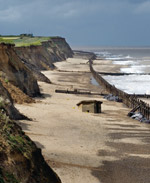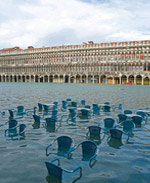- The uncertain future of the coasts
- > It is now accepted that global warming will result in a significant sea-level rise in future, with many low-lying coastal areas around the world being lost to the sea over the coming centuries. The wealthy industrialized countries will be able to defend themselves from the encroaching waters for a time, albeit with massive technological effort. In the long term, however, they too will have to withdraw back from the areas under threat or, alternatively, adapt to rising water levels.(See also: WOR 5, Coasts – A Vital Habitat Under Pressure)(See also: WOR 5, Coasts – A Vital Habitat Under Pressure)Further information on this topic is available here:

The future of the coast – defence or orderly retreat?
The shape of coastal zones is governed by a balance of different factors such as erosion stability, sedimentation, tides, storm frequency and ocean currents. Climate change, rising sea levels and human activity can disturb or intensify these factors and influence the equilibrium of the coasts. Such imbalances can usually be compensated for, to a certain crucial tipping point. Once this point is reached any changes are irreversible, and a return to the natural equilibrium is no longer possible. The combined effect of human activity and climate change are pushing many coastal areas towards their tipping point. In future, therefore, all building activity and the moving of substances such as dredged material must be planned very carefully with a thought to sustainability. This calls for an integrated coastal zone management system. Without doubt sea levels will rise slowly at first, speeding up and continuing well beyond the 21st century. Gradually, many coastal areas will become uninhabitable. People will lose their homes and a part of their culture. Affluent coastal nations will be able to slow down this process for some time, but will have to invest enormous financial and technical capital on measures of protection and adaptation. For the present time Germany will not depart from its strategy of defence along the coastlines of the North and Baltic Seas. The cost-benefit ratio of coastal protection (for people and material assets) is favourable. However, here too the population will in the long term be forced to decide whether to retreat from these coastal areas or to adapt to the advancing sea. Architects in the Netherlands are already building the first floating settlements which, firmly anchored to the land, can float at high tide. This is a good example of the strategy of adaptation – people are learning to live with the water. In future people in many places will have to adopt similar sustainable land-use and development planning strategies. This applies particularly to the severely threatened shorelines below 5 metres. It is also conceivable that buffer zones will be established in settlement areas, where building will be allowed only in accordance with certain low-risk specifications. In some flood-prone areas no high-quality homes or businesses may be located on the ground floor even today. In the medium term, however, there is one main objective: to limit climate change and sea-level rise as much as possible by taking action to mitigate climate change.


![The battle for the coast – © [M], Beate Zoellner/Bildmaschine.de](https://worldoceanreview.com/wp-content/images/wor1/kapitel_03c_k.jpg)